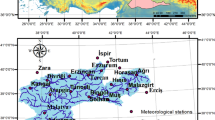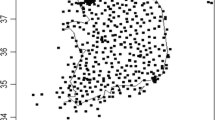Abstract
A new and general approach is proposed for interpolating 6-h precipitation series over large spatial areas. The outputs are useful for distributed hydrological modelling and studies of flooding. We apply our approach to large-scale data, measured between 2014 and 2016 at 159 weather stations network of Meteo Romania, using weather radar information and local topography as ancillary data. Novelty of our approach is in systematic development of a statistical model underlying the interpolation. Seven methods have been tested for the interpolation of the 6-h precipitation measurements: four regression methods (linear regression via ordinary least squares (OLS), with and without logarithmic transformation, and two models of generalized additive model (GAM) class, with logarithmic and identity links), and three regression-kriging models (one uses semivariogram fitted separately every 6-h, based on the residuals of the GAM with identity links models, and other two with pooled semivariograms, based on the OLS and GAM with identity links models). The prediction accuracy of the spatial interpolation methods was evaluated on a part of the dataset not used in the model-fitting stage. Due to the good results in interpolating sub-daily precipitation, normal general additive model with identity link followed with kriging of residuals with kriging parameters estimated from pooled semivariograms was applied to construct the final 6-h precipitation maps (PRK-NGAM). The final results of this work are the 6-h precipitation gridded datasets available in high spatial resolution (1000 m × 1000 m), together with their estimated accuracy.








Similar content being viewed by others
References
Aalto J, Pirinen P, Heikkinen J, Venäläinen A (2013) Spatial interpolation of monthly climate data for Finland: comparing the performance of kriging and generalized additive models. Theor Appl Climatol 112:99–111
Apostu A et al (2005) Evaluation of the radar precipitation measurement accuracy using rain gauge data. World meteorological organization commission for instruments and methods of observation
Arora M, Singh P, Goel NK, Singh RD (2006) Spatial distribution and seasonal variability of rainfall in a mountainous basin in the Himalayan region.Water Resour Manag 20:489–508
Boudevillain B, Delrieu G, Wijbrans A, Confoland A (2016) A high-resolution rainfall re-analysis based on radar–raingauge merging in the Cévennes-Vivarais region, France. J Hydrol 541:14–23
Burcea S, Cheval S, Dumitrescu A, Antonescu B, Bell A, Breza T (2011) Comparison between radar estimated and rain gauge measured precipitation in the Moldavian Plateau. Environ Eng Manag J 11(4):723–731
Burcea S, Dumitrescu A (2012) Impacts of wind farms on weather radar data and spatial rainfall estimation. Rom Rep Phys 64:1072–1084
Burcea S, Antonescu B, Bell A (2010) Data quality of the Romanian WSR-98D weather radar systems. In Proceedings, 6th European Conf. on Radar in Meteorology and Hydrology: Advances in Radar Technology, Sibiu, Romania, pp 322–325
Burnham KP, Anderson DR (1998) Model selection and inference. Springer, Berlin
Camera C et al (2014) Evaluation of interpolation techniques for the creation of gridded daily precipitation (1 × 1 km2); Cyprus, 1980–2010. J Geophys Res: Atmos 119:693–712
Cecinati F, Wani O, Rico-Ramirez MA (2017) Comparing approaches to deal with non‐gaussianity of rainfall data in Kriging‐Based Radar‐Gauge rainfall merging. Water Resour Res 53(11):8999–9018
Cecinati F, Moreno-Ródenas A, Rico-Ramirez M, ten Veldhuis MC, Langeveld J (2018) Considering rain gauge uncertainty using Kriging for uncertain data. Atmosphere 9(11):446
Cheval S et al (2011) Climatologic adjustments to monthly precipitation in Romania. Int J Climatol 31:704–714
Chubb T, Manton MJ, Siems ST, Peace AD, Bilish SP (2015) Estimation of wind-induced losses from a precipitation gauge network in the Australian Snowy Mountains. J Hydrometeorol 16(6):2619–2638
Colli M, Lanza LG, La Barbera P, Chan PW (2014) Measurement accuracy of weighing and tipping-bucket rainfall intensity gauges under dynamic laboratory testing. Atmos Res 144:186–194
Craciun C, Catrina O (2016) An objective approach for comparing radar estimated and rain gauge measured precipitation. Meteorol Appl 23:683–690
Dumitrescu A, Birsan MV (2015) ROCADA: a gridded daily climatic dataset over Romania (1961–2013) for nine meteorological variables. Nat Hazards 78:1045–1063
Dumitrescu A, Birsan MV, Manea A (2016) Spatio-temporal interpolation of sub-daily (6 h) precipitation over Romania for the period 1975–2010. Int J Climatol 36:1331–1343
Erdin R (2013) Geostatistical methods for hourly radar-gauge combination: An explorative, systematic application at MeteoSwiss, MeteoSchweiz, 2013
Faure D, Delrieu G, Gaussiat N (2019) Impact of the Altitudinal Gradients of Precipitation on the Radar QPE Bias in the French Alps. Atmosphere 10(6):306
Gaume E et al (2009) A compilation of data on European flash floods. J Hydrol 367:70–78
Goudenhoofdt E, Delobbe L (2009) Evaluation of radar-gauge merging methods for quantitative precipitation estimates. Hydrol Earth Syst Sci 13:195–203
Gräler B, Rehr M, Gerharz L, Pebesma E (2012) Spatio-temporal analysis and interpolation of PM10 measurements in Europe for 2009. ETC/ACM, s.l.
Harrell FE Jr (2015) Regression modeling strategies: with applications to linear models, logistic and ordinal regression, and survival analysis. Springer, s.l., Berlin
Hastie TJ, Tibshirani RJ (1990) Generalized additive models. Chapman & Hall/CRC, s.l., London
He Y et al (2018) Incorporating satellite precipitation estimates into a radar-gauge multi-sensor precipitation estimation algorithm. Remote Sens 10
Hengl T, Heuvelink GBM, Rossiter DG (2007) About regression-kriging: From equations to case studies. Comput Geosci 33:1301–1315
Jarvis A, Reuter HI, Nelson A, Guevara E (2006) Hole-filled seamless SRTM data V3. International Centre for Tropical Agriculture (CIAT), p 2006
Jewell SA, Gaussiat N (2015) An assessment of kriging-based rain‐gauge–radar merging techniques. Q J R Meteorol Soc 141(691):2300–2313
Jones MR et al (2013) Generalized additive modelling of daily precipitation extremes and their climatic drivers. National Center for Atmospheric Research, Colorado
Krajewski WF, Vignal B, Seo BC, Villarini G (2011) Statistical model of the range-dependent error in radar-rainfall estimates due to the vertical profile of reflectivity. J Hydrol 402(3–4):306–316
Lewis E, Quinn N, Blenkinsop S, Fowler HJ, Freer J, Tanguy M, Woods R (2018) A rule based quality control method for hourly rainfall data and a 1 km resolution gridded hourly rainfall dataset for Great Britain: CEH-GEAR1hr. J Hydrol 564:930–943
McCullagh P, Neldez JA (1989) Generalized Linear Models, no. 37 in Monograph on Statistics and Applied Probability. Chapman & Hal, s.l., London
McKee JL, Binns AD (2016) A review of gauge–radar merging methods for quantitative precipitation estimation in hydrology. Can Water Resour J/Revue canadienne des ressources hydriques 41:186–203
McMillan H, Krueger T, Freer J (2012) Benchmarking observational uncertainties for hydrology: rainfall, river discharge and water quality. Hydrol Process 26(26):4078–4111
Nanding N, Rico-Ramirez MA, Han D (2015) Comparison of different radar-raingauge rainfall merging techniques. J Hydroinformatics 17(3):422–445
R Core Team (2017) R: A Language and Environment for Statistical Computing. s.n, Vienna
Ranhao S, Baiping Z, Jing T (2008) A multivariate regression model for predicting precipitation in the Daqing Mountains. Mt Res Dev 28:318–325
Saltikoff E, Lopez P, Taskinen A, Pulkkinen S (2015) Comparison of quantitative snowfall estimates from weather radar, rain gauges and a numerical weather prediction model
Savina M et al (2012) Comparison of a tipping-bucket and electronic weighing precipitation gage for snowfall. Atmos Res 103:45–51
Sebastianelli S, Russo F, Napolitano F, Baldini L (2013) On precipitation measurements collected by a weather radar and a rain gauge network. Nat Hazards Earth Syst Sci 13:605
Setiawati MD, Miura F (2016) Evaluation of GSMaP daily rainfall satellite data for flood monitoring: Case Study—Kyushu Japan. J Geosci Environ Prot 4:101
Sezer A, Kilinc K, Yazici B (2016) Modelling extreme rainfalls using generalized additive models for location, scale and shape parameters. Appl Ecol Environ Res 14:635–644
Shen Y et al (2018) China’s 1 km merged gauge, radar and satellite experimental precipitation dataset. Remote Sens 10
Stauffer R et al (2017) Spatio-temporal precipitation climatology over complex terrain using a censored additive regression model. Int J Climatol 37:3264–3275
Taylor KE (2001) Summarizing multiple aspects of model performance in a single diagram. J Geophys Res 106:7183–7192
Velasco-Forero CA, Sempere-Torres D, Cassiraga EF, Gómez-Hernández JJ (2009) A non-parametric automatic blending methodology to estimate rainfall fields from rain gauge and radar data. Adv Water Resour 32(7):986–1002
Villarini G, Krajewski WF (2010) Review of the different sources of uncertainty in single polarization radar-based estimates of rainfall. Surv Geophys 31:107–129
Villarini G, Seo BC, Serinaldi F, Krajewski WF (2014) Spatial and temporal modeling of radar rainfall uncertainties. Atmos Res 135:91–101
Wang S et al (2014) Comparison of interpolation methods for estimating spatial distribution of precipitation in Ontario, Canada. Int J Climatol 34:3745–3751
Wood SN (2006) Generalized additive models: An introduction with R. s.l. Chapman & Hall/CRC, London
Young CB et al (1999) An evaluation of NEXRAD precipitation estimates in complex terrain. J Geophys Res : Atmos 104:19691–19703
Zhang Y, Yuyu R, Wang G (2019) Bias correction of gauge data and its effect on precipitation climatology over mainland China. J Appl Meteorol Climatol 58(10):2177–2196
Funding
The authors would like to thank the European Union and Romanian National Authority for Scientific Research and Innovation (UEFISCDI) for funding, in the frame of the collaborative international consortium IMDROFLOOD financed under the ERA-NET Cofound WaterWorks2014 Call. This ERA-NET is an integral part of the 2015 Joint Activities developed by the Water Challenges for a Changing World Joint Programme Initiative (Water JPI). This work was supported by the grant of the UEFISCDI, project number 81/2016, within PNCDI III. The work was also partially supported by the long-term strategic development financing of the Institute of Computer Science (Czech Republic RVO 67985807).
Author information
Authors and Affiliations
Corresponding author
Ethics declarations
Conflict of Interest
None.
Additional information
Publisher's Note
Springer Nature remains neutral with regard to jurisdictional claims in published maps and institutional affiliations.
Electronic Supplementary Material
ESM 1
(DOCX 1.18 mb)
Rights and permissions
About this article
Cite this article
Dumitrescu, A., Brabec, M. & Matreata, M. Integrating Ground-based Observations and Radar Data Into Gridding Sub-daily Precipitation. Water Resour Manage 34, 3479–3497 (2020). https://doi.org/10.1007/s11269-020-02622-4
Received:
Accepted:
Published:
Issue Date:
DOI: https://doi.org/10.1007/s11269-020-02622-4




